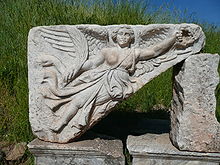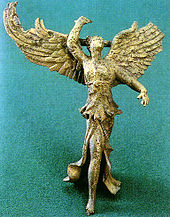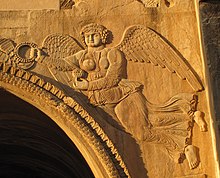Nike (mythology)
| Nike | |
|---|---|
Goddess of victory | |
 Stone carving of the goddess Nike at the ruins of the ancient city of Ephesus | |
| Abode | Mount Olympus |
| Symbol | golden sandals, wings, wreaths |
| Genealogy | |
| Parents | Pallas and Styx |
| Siblings | Kratos, Bia, Zelus |
| Equivalents | |
| Roman | Victoria |
In ancient Greek civilization, Nike (/ˈnaɪkiː/; Ancient Greek: Νίκη, lit. 'victory', ancient: [nǐːkɛː], modern:[ˈnici]) was a goddess who personified victory. Her Roman equivalent was Victoria.
Etymology

The word νίκη (nikē) is of uncertain etymology. R. S. P. Beekes has suggested a Pre-Greek origin.[1] Others have connected it to Proto-Indo-European *neik- (“to attack, start vehemently”) making it cognate with Ancient Greek: νεῖκος (neîkos, "strife") and Lithuanian: ap-ni̇̀kti ("to attack").[2]
Family

Nike is the daughter of the Titan Pallas and the goddess Styx, and the sister of Kratos (Strength), Bia (Force), and Zelus (Zeal).[3] Her grandfather is Poseidon.
And Styx the daughter of Ocean was joined to Pallas and bore Zelus (Emulation) and trim-ankled Nike (Victory) in the house. Also she brought forth Kratos (Strength) and Bia (Force), wonderful children.
In other sources, Nike was described as the daughter of Ares, the god of war. [4]
Ares ... O defender of Olympos, father of warlike Nike (Victory).
Mythology
Nike and her siblings were close companions of Zeus, the dominant deity of the Greek pantheon. According to classical (later) myth, Styx brought them to Zeus when the god was assembling allies for the Titanomachy against the older deities. Nike assumed the role of the divine charioteer, a role in which she often is portrayed in Classical Greek art. Nike flew around battlefields rewarding the victors with glory and fame, symbolized by a wreath of laurel leaves (bay leaves).[citation needed]

Cult
Sculptures of Nike were extremely common in Ancient Greece and used both in secular public spaces of many categories as well as in the temples of other gods. She was often seen as a miniature sculpture in the hand of Athena and Zeus. Nike was also depicted with famous athletes, symbolizing their victories. In public places as well as temples, she was depicted in sculpture to commemorate victories in war and competitions.
While Nike was often depicted in sculpture and often included in the cults of other gods, particularly Zeus and Athena, only a few sanctuaries dedicated solely to her are mentioned. Pausanias noted that there was an altar solely to Nike in Olympia close to the altar of Zeus Purifier,[5] and he also noted the temple of Nike in Athens: "On the right of the gateway [of the Akropolis (Acropolis) in Athens] is a temple of Nike Apteron (Wingless)."[6]
Depiction

Nike is seen with wings in most statues and paintings, with one of the most famous being the Winged Victory of Samothrace in the Louvre. Most other winged deities in the Greek pantheon had shed their wings by Classical times. Nike was a very close acquaintance of Athena, and is thought to have stood in Athena's outstretched hand in the statue of Athena located in the Parthenon.[7] Nike is also one of the most commonly portrayed figures on Greek coins.[8] After victory at the Battle of Marathon, Athenians erected the Nike of Callimachus.[9]
Names stemming from Nike include among others: Nikolaos, Nicholas, Nicola, Nick, Nicolai, Niccolò, Nikolai, Nicolae, Nils, Klaas, Nicole, Ike, Niki, Nikita, Nikitas, Nika, Nieke, Naike, Niketas, Nikki, Nico, and Veronica.
Contemporary usage
- The sports equipment company Nike, Inc., is named after the Greek goddess Nike.[10]
- Project Nike, an American anti-aircraft missile system, is named after the goddess Nike.[11]: 3
- Since Giuseppe Cassioli's design for the 1928 Summer Olympics, the obverse face of every Olympic medal bears Nike's figure holding a palm frond in her right hand and a winner's laurel crown in her left.[12][13]
- The Honda motorcycle company's wing logo was inspired by the goddess Nike.[14]
Family tree
| ||||||||||||||||||||||||||||||||||||||||||||||||||||||||||||||||||||||||||||||||||||||||||||||||||||||||||||||||||||||||||||||||||||||||||||||||||||||||||||||||||||||||||||||||||||||||||||||||||||||||||||||||||||||||||||||||||||||||||||||||||||||||||||||||||||||||||||||||||||||||||||||||||||||||||||||||||||||||||||||||||||||||||||||||||||||||||||||||||||||||||||||||||||||||||||||||||||||||||||||||||||||||||||||||||||||||||||||||||||||||||||||||||||||||||||||||||||||||||||||||||||||||||||||||||||||||||||||||||||||
See also
- Winged Victory of Samothrace
- Altar of Victory
- Nike of Paeonius
- Victory, 1902 statue in New York City by Augustus Saint-Gaudens
- The obverse of Saint-Gaudens' 1907 United States Saint-Gaudens double eagle coin is based on his sculpture of Victory
- Ángel de la Independencia
- 307 Nike
Notes
- ^ R. S. P. Beekes, Etymological Dictionary of Greek, Brill, 2009, pp. 1021–2.
- ^ Blümel, Wolfgang (24 August 1982). "Zeitschrift für vergleichende Sprachforschung auf dem Gebiete der Indogermanischen Sprachen: Ergänzungshefte". Vandenhoeck & Ruprecht – via Google Books.
- ^ Smith, Nice.
- ^ https://www.theoi.com/Olympios/AresAttendants.html
- ^ Pausanias, Description of Greece 5. 14. 8
- ^ Pausanias, Description of Greece 1. 22. 4 (trans. Jones) (Greek travelogue C2nd A.D.)
- ^ "Nike: Greek goddess of victory". Theoi.com. Retrieved 2011-11-15.
- ^ Sayles, Wayne G. (2007). Ancient Coin Collecting II. Krause Publications. p. 149. ISBN 978-0-89689-516-4.
- ^ Pantermalis, Dimitris. "Nike of Callimachus" (PDF). www.snf.org. Dimitris Pantermalis President of the Acropolis Museum.
- ^ Levinson, Philip. "How Nike almost ended up with a very different name". Business Insider. Retrieved 2017-06-07.
- ^ Morgan, Mark L.; Berhow, Mark A. (2002). Rings of Supersonic Steel: Air Defenses of the United States Army 1950-1979 : an Introductory History and Site Guide. Hole In The Head Press. ISBN 978-0-615-12012-6.
- ^ Winner's medal for the 1948 Olympic Games in London, Olympic.org. Accessed 5 August 2011.
- ^ "Picture of 2004 Athens Games Medal". Retrieved 2010-01-28.
- ^ "The Honda logotype | The Honda Trials History". www.onlytrial.com. Archived from the original on 2018-06-28. Retrieved 2017-05-19.
References
- Smith, William; A Dictionary of Greek and Roman Antiquities. William Smith, LLD. William Wayte. G. E. Marindin. Albemarle Street, London. John Murray. 1890. Online version at the Perseus Digital Library.
External links
 Media related to Nike at Wikimedia Commons
Media related to Nike at Wikimedia Commons The dictionary definition of Nike at Wiktionary
The dictionary definition of Nike at Wiktionary- Goddess Nike
